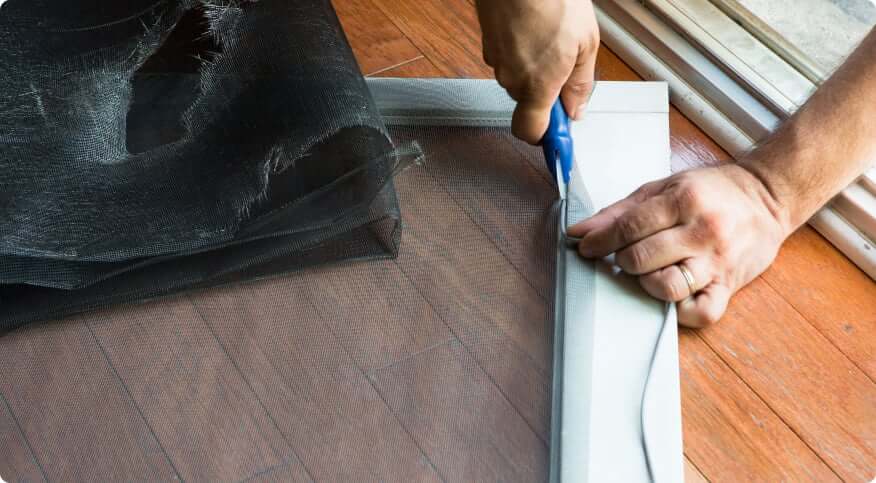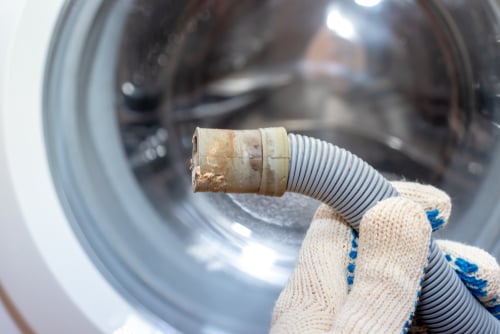As the warm weather rolls in, it’s time to open up the windows and doors to let the fresh air in! It’s one of the simple pleasures of the season. But sometimes this pleasure comes with a small problem – the unwelcome intrusion of bugs and pests through damaged screens.
Whether it's from wear and tear or Fido making his own doggie door, fixing window and door screens is surprisingly easy. With the right tools and know how, you'll have your screens fixed in no time!
Types of screen material
Understanding the kind of screen you're working with is the first step to a successful repair. They come in various materials, each with its distinct characteristics and repair methods, but the two most common types are fiberglass and aluminum.
Fiberglass screens are softer and have a slight give when pushed, making them non-corrosive and ideal for coastal homes.
Aluminum screens, on the other hand, feel more rigid and metallic, offering better resistance to tears and punctures, though they can dent and bend.
Assessing the damaged window or door screen
Before diving into repairs, take the time to evaluate the damage and determine whether a simple patch or a full replacement is needed.
Patching vs. replacing
Once you've identified the type of screen material you're dealing with, the next step is to evaluate the damage.
If your screen has small tears or holes, about the size of a quarter or smaller, you can typically address these issues with a patch. This approach offers a simple and cost-effective solution to minor damage.
However, if you're facing larger tears or more extensive wear, it may be necessary to replace the entire screen. Opting for a full replacement can provide long-term durability and ensure your home remains protected from pests and bugs.
Consider the following when deciding:
A patch may be noticeable, affecting your screen's appearance. If aesthetics are a concern, replacing the screen might be the preferred option.
Patching is generally less expensive and quicker, whereas replacing the screen provides a fresh start but involves more work and investment.
Time to fix the window or door screen
Once you evaluate the type of screen, the extent of the damage, and your personal priorities, you'll be ready to make the repair. Whether you're dealing with minor wear and tear or more significant issues, we've got you covered. Remember, if you need help at anytime, Frontdoor Handyperson Services are just a video chat away. Your first chat is free.
Patching small tears and holes
Patching is an ideal solution for small tears or holes. This simple method can extend the life of your screen without the need for full replacement: Here’s a straightforward, easy way to fix the window or door by patching:
Gather your materials
You’ll need a screen patch kit suitable for your screen type, scissors, and clear household glue if the kit requires it.
Clean the area
Before you start, ensure the damaged area is clean and dry. Use a wet cloth with mild detergent to clean, then dry with a clean cloth.
Cut the patch
If using a kit, cut a patch that covers the damaged area by at least half an inch on all sides. For fiberglass screens, you can use a piece of spare screen material.
Apply the patch
For adhesive patches, simply press it firmly over the hole. For non-adhesive patches, apply a thin layer of clear glue around the edges of the hole, then place the patch on top.
Secure and dry
Press the patch down firmly and allow any glue to dry completely.
This simple window and door fix can extend the life of your screen without the need for full replacement.
Replace the entire window or door screen
If the damage is too extensive for a patch, replacing the screen is the next step. Replacing the entire screen can make your windows or doors look like new. This process requires a bit more effort but is still easy to do yourself:
Remove the screen frame
Carefully take the frame out of the window or door and lay it on a flat surface.
Take out the old screen
Remove the spline (the rubber material that holds the screen in place) using a screwdriver or spline removal tool. Then, take out the old screen.
Measure and cut new screen
Lay your new screening material over the frame, leaving about two inches extra on each side. Cut the material to size with scissors.
Install the new screen
Press the new screen into the frame's groove using the convex side of a spline roller. Then, use the concave side to press the spline back into the groove over the new screen.
Trim excess material
Once the spline is securely in place, trim the excess screen material around the edges.
Whether opting for a quick patch or a complete replacement, knowing how to fix a window and door screen and taking the time to make the repair can significantly enhance your home's comfort and appeal as you enjoy the warmer months. And remember, if you encounter any issues along the way, Frontdoor is here to help with real-time Expert and Handyperson advice via video chat.
Was this article helpful?







